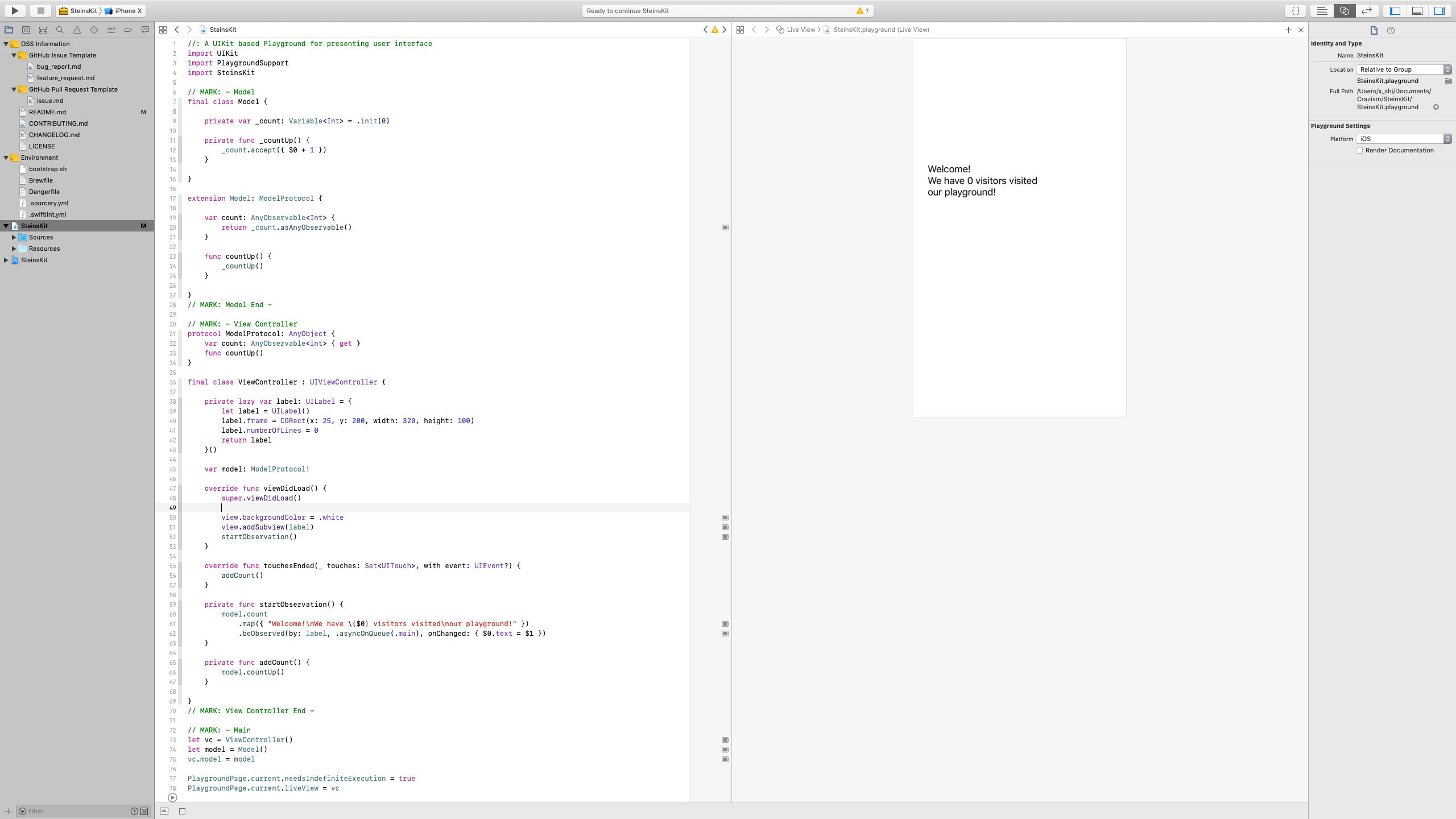This project is now deprecated because Apple has officially realeased Combine framework. Therefore I don't see any sensible reason to import a 3rd party library which does less.
If you have any interest to improve this project, please feel free to fork it :)
SteinsKit is a framework to help you implement Observer Pattern without any FRP concepts.
Please note that this framework hasn't been widely tested yet, and currently it's for iOS only.
Please open an issue or send me a pull request if you have any problems, better ideas or any other things you want me to know.
If you're a big fan of FRP, or you want to deeply dive into the world of Reactive Programming, probably libraries like RxSwift or ReactiveSwift would be a better choice for you.
However, if what you want is just a quick implement of Observer Pattern, and you don't want to care about the concepts in FRP like Streams or Hot/Cold Observables, you may want to try SteinsKit!
With SteinsKit, you don't have to care about what a stream is, or if the observable is hot or cold. The concept is very simple: you give the variable a new value, and all objects observing the variable receive the new value. That's it!
- iOS 11.0+
- Xcode 10.2+
- Swift 5.0+
github "el-hoshino/SteinsKit"- Run
carthage update. - Add the framework to your project.
- Download the whole repository.
- Add the NotAutoLayout project file into your project.
- Build the framework.
You can check a demo code in Playground. It looks like this:
But anyway, the core code that this framework does (and is aimed to) is like this:
model.count
.map({ "Welcome!\nWe have \($0) visitors visited\nour playground!" })
.beObserved(by: label, .asyncOnQueue(.main), onChanged: { $0.text = $1 })SteinsKit uses Variable and LazyVariable classes to store the value, the closures to handle when value changes, and the weak references of the observers. So the approach is very simple:
- Declare a
Variableor aLazyVariable, and expose it asAnyObservable. Please note that if you declare aVariable, you have to give it an initial value, which you don't have to if you declare aLazyVariable. - Subscribe the
AnyObservablethroughbeObserved(by:, onChanged:)method. If needed, you can also insertmap(_:)methods before subscribing it. And as you subscribing theAnyObservable, the latest value (if available) will be immediately reflected in youronChangedhandler. - Put new values to the
VariableorLazyVariablethroughaccept(_:)method from the object that holds it, and all objects subscribe it receive the new value immediately.
You may notice that in the sample above, there is no [weak object] capture list, or subscription disposing declarations like .disposed(by: disposeBag) which you may be familiar with if you use RxSwift. This is because:
- The object passed to
by:parameter inbeObservedmethod will be weakly referred inVariable. This makes the object acts like aDisposeBagin RxSwift, that when the object is released from memory, the subscription will also be released from theVariable. But if you'd like to choose another object to be the dispose bag, you can also set it withdisposerparameter inbeObservedmethod. - The object passed to
by:parameter inbeObservedmethod will also be sent toonChangedhandler closure as the first input parameter$0, and is already weakly captured inside thebeObservedmethod. So you don't have to declare it in the capture list manually in your code, and in addition you can directly use it in your closure with$1as the latest value.
In addition, you can also choose which queue to use for the observation. The settings are:
.async(DispatchQueue): TheonChangedhandler will run after the value changed, on the queue passed, usingDispatchQueue.async. Handy for UI components as the subscriber to redraw with latest values on main thread.- .
sync(DispatchQueue): TheonChangedhandler will run after the value changed, on the queue passed, usingDispatchQueue.sunc. Always remember that this may cause a deadlock if you don't use the threads properly. .directly: TheonChangedhandler will run immediatly after the value changed, just on the queue which changed the value.
And if you choose not to pass the queue parameter, .directly will be used.
All the design described above makes it much more simple to write an Observer Pattern code.
- No enough tests yet~, especially about the ARC~.
It doesn't mean anything. El Psy Kongroo.
SteinsKit is released under the Apache license. See LICENSE for details.



